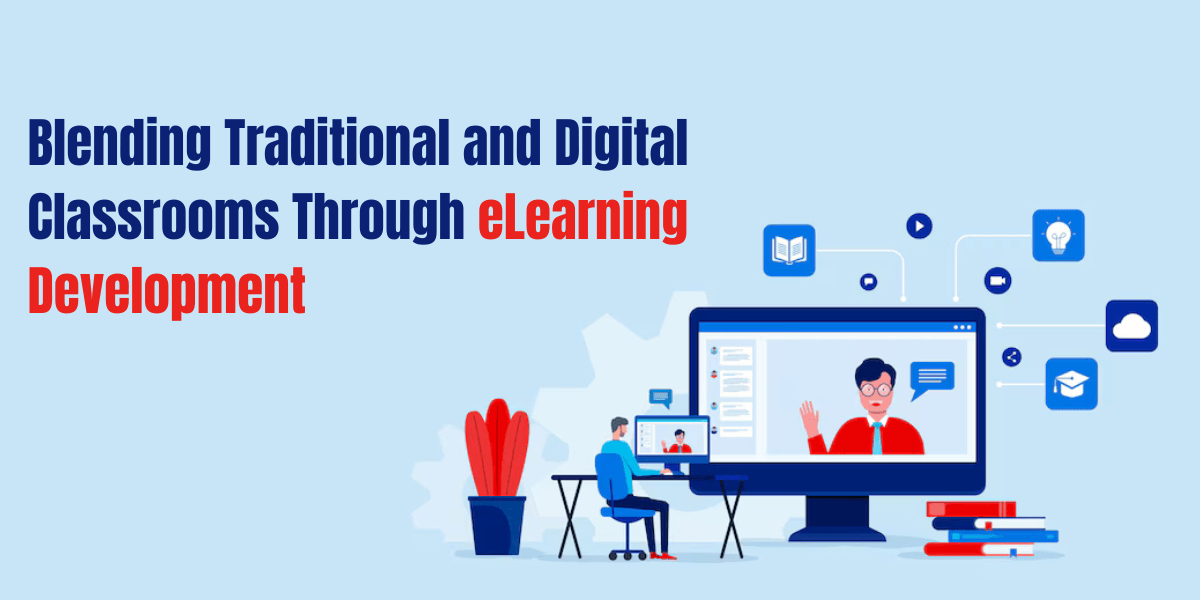Introduction: The Classroom Is No Longer a Single Space
In 2025, learning no longer begins and ends within the four walls of a classroom. It continues on screens, across devices, and through real-time interactions beyond physical boundaries. For educational institutions—from K-12 schools to higher education and vocational programs—the shift toward hybrid learning ecosystems is no longer an experiment. It’s an expectation.
The pandemic may have accelerated the adoption of digital platforms, but what has emerged post-crisis is far more strategic: a blended learning model that integrates the best of traditional classrooms with the flexibility and scalability of eLearning development.
This hybrid model isn’t just a matter of delivering lessons online. It’s about redefining how learning is structured, consumed, and assessed—and how educational outcomes are personalized at scale.
Why Hybrid Learning Is Becoming the Global Standard?
Education leaders today face increasingly complex demands: improve access to education, personalize learning experiences, support teacher performance, and deliver measurable outcomes for students. In a world where agility, equity, and scalability matter more than ever, achieving these goals through traditional, in-person classrooms alone has become impractical.
This is where hybrid learning has emerged as a transformative model, blending the best of physical and digital environments to meet modern expectations. Hybrid learning extends access beyond classroom walls, allowing students to engage with content anytime and from anywhere. Whether through asynchronous video modules or real-time virtual classrooms, this model ensures learning continuity even in disrupted or remote conditions.
Moreover, the integration of AI in hybrid platforms enables deep personalization. Intelligent recommendation engines tailor content pathways based on individual performance, interests, and pace, helping each learner move from concept to mastery in a way that feels both guided and self-directed. This level of adaptive learning is difficult, if not impossible, to replicate in conventional settings.
Educators also benefit immensely from this model. With built-in analytics, automated grading, and smart dashboards, teachers gain real-time insights into student progress, learning gaps, and content effectiveness. This data empowers them to make timely interventions and focus more on mentorship than on administrative tasks.
From a financial and operational standpoint, hybrid learning reduces infrastructure dependency and allows institutions to scale educational delivery without proportionate increases in cost. Instead of investing in more physical space or printed materials, institutions can reallocate budgets toward digital content creation, training, and innovation.
Most importantly, student engagement is heightened through the use of multimedia content, gamified quizzes, interactive simulations, and collaborative online tools. These features make learning more immersive, relatable, and aligned with the digital-native habits of today’s learners.
However, realizing the full potential of hybrid learning demands more than just selecting an off-the-shelf LMS or a reliable video conferencing solution. It requires custom eLearning development—an intentional, strategic approach that combines sound pedagogy, user-centric design, and advanced technology into a unified digital framework capable of delivering impact at scale.
eLearning Development: The Backbone of Blended Classrooms
At its core, eLearning development is not about digitizing content. It’s about architecting digital experiences that complement, enhance, and expand what educators do in the classroom.
A mature eLearning strategy focuses on five key dimensions:
1. Curriculum Integration and Flexibility
Every school or institution has its own curriculum structure. Effective eLearning platforms align digital modules with in-class syllabi, allowing students to prepare ahead, revise after, or explore concepts more deeply through interactive content.
A modular design approach also enables lesson branching, where students can choose paths based on interest or pace, making the digital journey truly personalized.
2. Real-Time and Asynchronous Learning Capabilities
Blended learning thrives on the ability to balance synchronous (live) and asynchronous (self-paced) instruction.
Custom eLearning platforms often include:
- Live classroom features with whiteboards, breakout rooms, and instant polls
- Recorded lessons for students who miss sessions or need to revisit
- Automated assignments and quizzes that reinforce learning after class hours
This dual-mode setup respects the classroom structure while enabling flexibility at scale.
3. Data-Driven Teaching and Learning
One of the most transformative aspects of modern eLearning development is its ability to deliver data insights.
Educators can now access:
- Real-time dashboards tracking student participation and performance
- Automated alerts for students falling behind or disengaged
- AI-based feedback loops that guide students to improve
With data integrated into the learning lifecycle, teachers no longer guess—they act on evidence.
4. Interoperability and Device Agnosticism
A successful blended learning system must work across devices, browsers, and network environments.
This is why modern eLearning development emphasizes:
- Mobile-first responsive design
- Offline access with content caching
- Integration with classroom tools like Google Classroom, Microsoft Teams, and SIS platforms
The goal: meet learners where they are, regardless of device or location.
5. Content Innovation Through Multimedia and Gamification
The digital part of the classroom cannot just replicate lectures—it must elevate engagement.
That’s where custom eLearning platforms shine, with features like:
- Gamified learning journeys with levels, rewards, and badges
- AR/VR modules that simulate labs, environments, and experiences
- Microlearning videos that make content digestible and engaging
When thoughtfully executed, digital content can create moments of “aha” that the classroom alone might not deliver.
Use Case: A Modern School System Adopts Hybrid Learning
A regional school board managing over 120 schools across urban and rural areas faced a pressing challenge: ensure uninterrupted education post-pandemic despite inconsistent device access and varying levels of digital readiness among teachers.
To bridge these gaps, the board deployed a custom eLearning solution. The platform was optimized for low-end smartphones, offered downloadable modules for offline learning, and featured AI-driven recommendations to guide students based on individual performance. It also integrated smoothly with physical lesson plans to support blended delivery.
The results were transformative—a 37% rise in attendance, notable test score improvements in rural zones, and a 50% reduction in manual grading time for teachers. When built with intent, hybrid learning becomes a strategic enabler of access, equity, and academic performance.
The Role of Expert Partners in eLearning Development
While off-the-shelf LMS platforms may serve as a temporary foundation, they often fall short when it comes to delivering lasting educational impact. True transformation in hybrid learning requires tailored eLearning solutions—ones that align closely with an institution’s pedagogy, learner profiles, and technical ecosystem.
This is where experienced eLearning development partners prove indispensable. They offer deep technical expertise in building scalable, cloud-native platforms that can grow with institutional needs. Their UX and UI design capabilities ensure that learning environments are not only functional but also engaging, accessible, and inclusive for diverse student populations.
Beyond design, expert partners integrate AI and machine learning to power intelligent personalization and real-time analytics—enabling educators to respond to student needs with precision. Just as importantly, they bring domain-specific knowledge of educational systems, regulatory compliance, and learning science, ensuring that every solution is grounded in academic integrity and operational feasibility.
The result isn’t merely a digital platform—it’s a pedagogical engine that amplifies teaching strategies and drives digital maturity across the institution.
What’s Next: Future Trends in Hybrid Learning
As blended learning continues to evolve, several future-forward trends are emerging:
- AI Tutors & Adaptive Assessments – Deliver real-time personalization by adjusting content to each learner’s performance.
- Blockchain-Based Credentialing – Enable secure, verifiable credentials that support lifelong and cross-institutional learning.
- Virtual Reality Classrooms – Facilitate immersive, global collaboration through virtual classroom exchanges.
- Edge Computing for Low-Bandwidth Access – Ensure smooth digital learning experiences even in remote or bandwidth-limited regions.
- Learning Record Stores (LRS) – Track and unify learner data across multiple platforms and learning environments.
- Scalable eLearning Frameworks – Prepare for the future with flexible, extensible systems that integrate emerging technologies seamlessly.
Final Thoughts: Bridging Worlds to Build the Future of Learning
The hybrid classroom is not a compromise—it’s an evolution. It brings together the intimacy of physical teaching with the power of digital personalization, analytics, and scale.
For institutions serious about driving learning outcomes in the next decade, investing in strategic eLearning development is essential.
It’s not just about staying current. It’s about building a learning ecosystem where every student, teacher, and institution thrives—regardless of geography, device, or schedule.
Blended learning is no longer the future. With the right strategy and the right development partner, it’s today’s most powerful educational advantage.






Tech content on this site may include contributed articles and partnerships with industry voices. Learn more in our Editorial Policy.